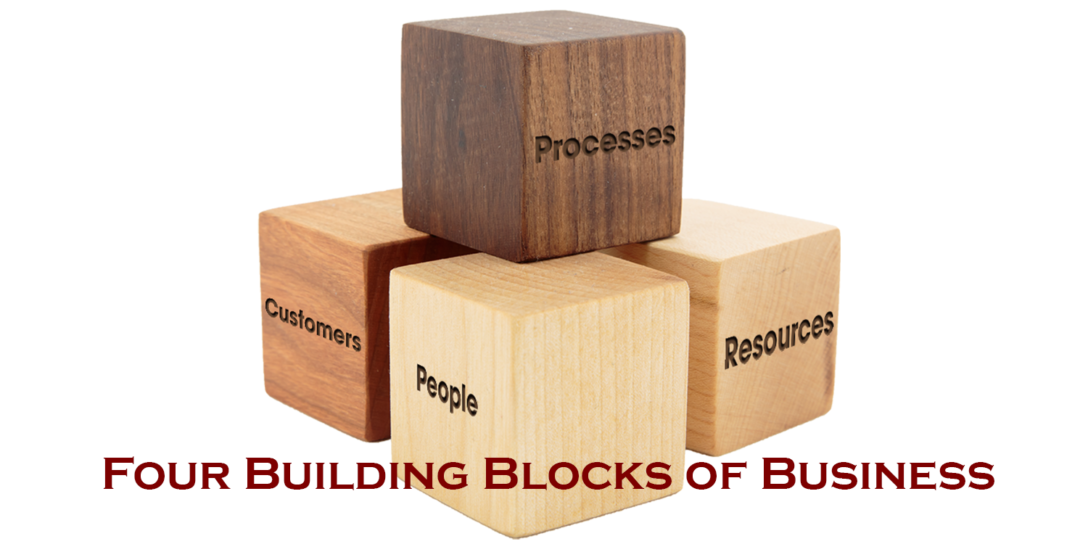The foundational building blocks of every business are Processes, People, Customers and Resources. Leaders, who strengthen and understand each one of these blocks, build their business. Those who weaken or neglect these building blocks, find themselves with declines in both their top and bottom lines. Let’s take a deeper look at each of the four building blocks
Processes
To Achieve our Vision What Business Process Will We Need to Excel At
A company is a set of processes. What is the difference between Verizon and AT&T or Mobil and Shell? Some may say everything, but really It’s their processes. Most of the time, a company’s processes come about in an ad hoc fashion based on the needs and observations of the people at the time the process is implemented. Seldom, if ever, do leaders take a step back to review their processes - individually or in aggregate - to eliminate inefficiencies and optimize performance. Leaders are frequently engulfed in the day-to-day activities of answering emails, attending meetings, returning calls and resolving conflicts. They neglect to focus on the overall effectiveness of their processes. They simply do not have the time or energy to focus on their processes.
Believe it or not, organizations can sometimes forget that creating and delivering top quality products and providing excellent services is their main objective. Organizations keep ineffective processes in effect because it is comfortable, safe and familiar. In general, people do not like change even when it is for their own benefit. Therefore, weak leaders do not always change unproductive processes. They do not want to upset their people or cause more work for themselves.
Leaders must regularly set aside time to define and redefine their processes, track defects and poor service, and make improvements to solidify this building block.
People
To Achieve our Vision, What Must Our People Learn and How Must We ImproveThe People building block is arguably the most important block of any business and is the most difficult to manage. Leaders go to college and graduate schools to learn how to manage people. We read books, take courses, and listen to podcasts to improve our managerial skills and still we get negative feedback on our 360s. It is okay, as long as the leader has a vision for the type culture they are striving to manifest and recognize that every action or inaction they take will either bring them closer to or push them further away from that vision.

Additionally, the leader must be consistently focused on improving themselves as well as their organization. Leaders must strive to create learning organizations where the organization is always pushing to improve. An organization where employees feel valued and are contributing according to their abilities.Effective management will create an organization where personal growth is expected and rewarded and employees are both challenged and satisfied. Employees who are motivated by the company’s vision and mission will produce profitability, but frustrated employees will lead to losses.
Customers
To Achieve our Vision, How Should We Appear to Our Customers
Customer acquisition is expensive. In order to acquire new customers, companies must effectively target, market to and convince customers to try their product or service. When most businesses begin, they do a lot of advertising. They are hungry for customers. Existing business treat advertising as an afterthought. They take for granted their customers will always be there. A lot of businesses spend money on every and anything, they believe will bring more customers. Unfortunately, there is nothing strategic, inexpensive or effective about a shot gun approach. Consequently, leaders get disappointed when their efforts bare no fruit.
Many business owners do not take time to figure out who is their target customer. What are their target customer’s likes, dislikes, needs and wants? Which types of media do they consume? What is the cheapest way to reach them? How much is the target customer willing to pay for their products or services? Where and how should we sell our products? Worst of all, once leaders answer these and other questions and develop a plan, they do not stick to it long enough to get results. All of these questions and more must be answered in order to develop an effective marketing plan to acquire new customers.
Customer retention is inexpensive compared to acquisition. Therefore, it is better to keep an existing customer than to find a new one. I view customer retention like a personal relationship. In a personal relationship, you expect to have communication, honesty, integrity, support, benefits and an apology when necessary. Likewise, in a business relationship, customers expect that you communicate with them periodically and let them know when something special is happening or when something is wrong. Customers want to deal with companies that have high ethical and moral standards. They need and want support when they are having difficulties and crave some benefits every now then. Most of all, customers do business with businesses that admit their mistakes and fix them quickly. Companies that invest in developing customer relationships with the aforementioned will reap the benefits of their efforts.
Resources
To Achieve Our Vision, What Resources Do We Need and How Dow We Account For ThemA company’s financial wherewithal is the assets and access to capital it has to take on and sustain the business activities necessary to achieve the monetary requirements of the shareholders both now and in the future. Let’s look at three aspects of a company’s financial wherewithal: working capital, access to credit and assets.

Working capital is like the oil in a car. The car’s engine will seize up without oil and likewise your business will stop running without working capital. Small and mid-size businesses must master the ability to manage their working capital and cash flow. A smart manager should ask themselves, what are my working capital requirements?
Access to capital is critical. In fact, many companies go out of business due to lack of capital. For most businesses, there will come a point in time when the company needs to borrow money to maintain liquidity or purchase assets. In order to borrow money, small businesses and their owners must have good credit. Yes, small businesses have credit scores, and must meet certain financial standards. What is my credit score? What does my company’s credit look like?
Assets are what the company owns. Cash, equipment and inventory are all assets. Companies must have the right kind of inventory and the right type of equipment to be profitable. How quickly does my inventory turnover?
In Summary
The questions above are just some of the questions that must be answered to ensure that a company’s financial standing is strong and durable.
There are many tools to monitor and measure the financial wherewithal of a company. There are accounting and POS software packages, industry specific applications, financial statements, spreadsheets, financial tests, shopping carts for websites and more. Every company has access to profit & loss, balance sheet and cash flow statements. Management is either using accounting software or someone is preparing the reports for them. Do you have the right tools? Do you have enough tools?
Many companies have these tools, but far too often the responsible individuals do not have the competencies and the skills to effectively use them. How well does senior management understand the company’s financials and its correlation to their strategy? Do these managers understand which parts of the company need investment, where cuts can be made and why? Managers must take the time to learn the relationships and interdependencies between their tools and the reports they use to maximize their resources.
Each one of these building blocks must be nurtured, developed, and strengthened on an ongoing basis to continue company growth . This is the job all leaders and managers. Hopefully, I have peaked your interest enough for you to take the time to learn a little bit more about each of these building blocks in your business.

